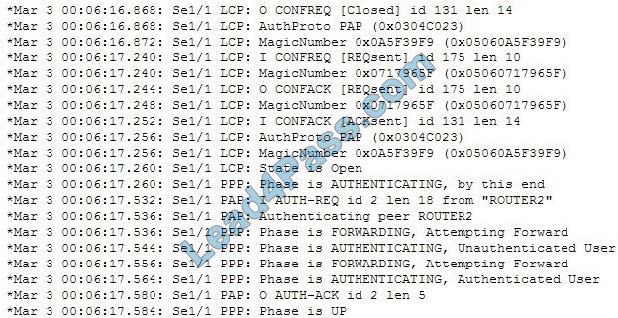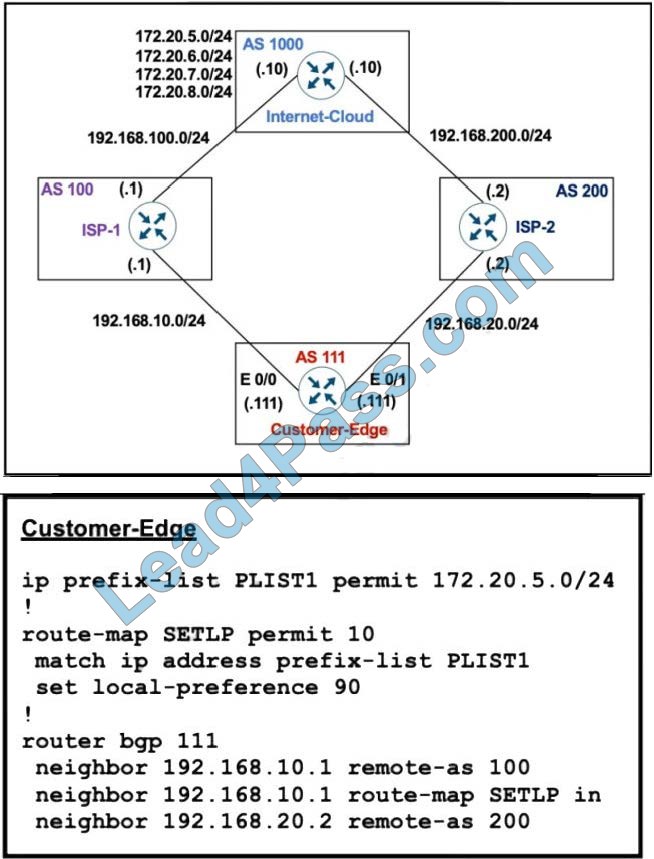Leads4Pass 300-410 dumps with PDF and VCE | Fro 300-410 ENARSI exam in 2022-2023

leads4pass 300-410 dumps with PDF and VCE, containing 737 latest exam questions and answers, Including 2022 Newest Simulation Labs, is currently the most effective 300-410 ENARSI certification exam material for the 2022-2023 certification exam.
Use leads4pass 300-410 dumps: https://www.leads4pass.com/300-410.html to clarify goals for candidates, speed up their learning progress, and ensure that they pass the exam successfully.
Read a portion of the free 300-410 exam questions and answers online
Question 1:
DRAG DROP
Drag and drop the addresses from the left onto the correct IPv6 filter purposes on the right.
Select and Place:

Correct Answer:

HTTP and HTTPs run on TCP port 80 and 443, respectively and we have to remember them.
Syslog runs on UDP port 514 while NTP runs on UDP port 123 so if we remember them we can find out the matching answers easily.
But maybe there is some typos in this question as 2001:d88:800:200c::c/126 only ranges from 2001:d88:800:200c:0:0:0:c to 2001:d88:800:200c:0:0:0:f (4 hosts in total).
It does not cover host 2001:0D88:0800:200c::1f. Same for 2001:D88:800:200c::e/126, which also ranges from 2001:d88:800:200c:0:0:0:c to 2001:d88:800:200c:0:0:0:f and does not cover host 2001:0D88:0800:200c::1c.
Question 2:
Which commands will display the other routers with which the local router has established an adjacency with, including hold time and uptime parameters?
A. show ip eigrp neighbors
B. show ip route
C. show adjacencies
D. show eigrp neighbors
Correct Answer: A
The show ip eigrp neighbors command will display the neighboring EIGRP routers with which the local router has established an adjacency.
It will also display hold time and uptime statistics. In this case, the uptime statistic refers to how long the adjacency has been established. A sample output of the show ip eigrp neighbors command is below.
Router2# show ip eigrp neigh IP-EIGRP neighbors for process 100 H Address Interface Hold Uptime SRTT RTO Q Seq (sec) (ms) Cnt Num
1 10.20.0.1 Se1 11 22:37:26 28 200 0 2
0 10.10.0.1 Se0 13 22:38:09 19 200 0 4
The show ip route command simply displays the routing table and does not provide neighbor information.
The other commands are not valid IOS commands.
Objective:
Layer 3 Technologies
Sub-Objective:
Configure and verify EIGRP neighbor relationship and authentication
References:
Cisco IOS IP Routing: EIGRP Command Reference > show ip eigrp neighbors
Question 3:
You have a DMVPN hub with the following configuration applied:

What problem could occur if the bandwidth 1000 command were missing from the tunnel interface?
A. the tunnel interface will intermittently flap up and down
B. split horizon will prevent routing updates from traversing from spoke to spoke
C. congestion will develop in the tunnel interface
D. the IPsec association will fail
Correct Answer: A
In the absence of a bandwidth command on the tunnel interface, the default bandwidth on a tunnel interface is 9 Kbps. EIGRP will use 50% of that (4.5K), which is too low. This will cause problems with the maintenance of EIGRP neighbor
relationships. From time to time this will cause the tunnel to flap up and then down as the relationships go up and down. When you execute the bandwidth command it has no real effect on the bandwidth of the link but it will allow EIGRP to
use 50% of 10k or 5k for its purposes, leaving 4k for data. This will have little impact on the data while maintaining the neighbor relationships.
The bandwidth command will have no effect on split horizon. There will be no problems with split horizon, even though the output shows that it has been disabled on the tunnel interface with the no ip split-horizon eigrp 1 command.
The bandwidth command will not cause congestion on the link. It will only lower the bandwidth available to data from 4.5K to 4K.
The bandwidth command will not cause the IPsec association to fail. There is sufficient bandwidth for this process.
Objective:
VPN Technologies
Sub-Objective:
Describe DMVPN (single hub)
References:
Understanding Cisco Dynamic Multipoint VPN – DMVPN, mGRE, NHRP
Question 4:
Refer to the exhibit.

A network administrator is discovering a Cisco Catalyst 9300 and a Cisco WLC 3504 in Cisco DNA Center. The Catalyst 9300 is added successfully. However, the WLC is showing error “uncontactable” when the administrator tries to add if in Cisco DNA Center.
Which action discovers WLC in Cisco DNA Center successfully?
A. Delete the WLC 3504 from Cisco DNA Center and add it to Cisco DNA Center again.
B. Add the WLC 3504 under the hierarchy of the Catalyst 9300 connected devices.
C. Copy the .cert file from the Cisco DNA Center on the USB and upload it to the WLC 3504.
D. Copy the .pem file from the Cisco DNA Center on the USB and upload it to the WLC 3504.
Correct Answer: D
Question 5:
Which of the following commands need to be configured on a RIPng router prior to enabling this routing protocol?
A. ipv6 rip enable
B. ipv6 multicast-routing
C. ipv6 unicast-routing
D. ipv6 router rip
Correct Answer: C
The ipv6 unicast-routing command should be used before enabling RIPng on a router. This command should be executed in global configuration mode of the router. IPv6 can then be enabled by using the ipv6 enable command on any of the interfaces of the router.
The ipv6 unicast-routing command allows you to forward IPv6 unicast datagrams.
Routing Information Protocol Next Generation (RIPng) allows routers to learn about routes in an autonomous system. RIPng is an extension of the RIPv2 protocol to provide support IPv6 for future adherence.
The similarities between RIPv2 and RIPng are as follows:
Both protocols use User Datagram Protocol (UDP).
Both use distance vector algorithm to find the best route.
Both of them measure the metric in terms of hops.
Both have the same maximum hop count of 15 for valid routes.
The differences between RIPv2 and RIPng are as follows:
RIPv2 learns IPv4 routes, whereas RIPng learns IPv6 routes
RIPv2 supports automatic summarization as IPv4 defines classful addresses, whereas RIPng does not support automatic summarization RIPv2 uses UDP port 520, whereas RIPng supports port 521
RIPv2 requires authentication for RIP packets, whereas RIPng does not require RIP-specific authentication as IPv6 has an in-built IPsec authentication
The ipv6 rip enable command should not be used because this command allows you to enable IPv6 RIP routing process on the interfaces of a router.
You should not use the ipv6 multicast-routing command prior to enabling IPv6 on the router. This command is used after IPv6 is enabled on one or more interfaces of the router to allow multicast forwarding using Protocol Independent
Multicast (PIM) and Multicast Listener Discovery (MLD) on all the IPv6-enabled interfaces.
The ipv6 router rip command should not be used prior to enabling IPv6 because it allows you to enter the RIP for IPv6 router mode.
Objective:
Layer 3 Technologies
Sub-Objective:
Describe RIPng
References:
Cisco > Configuring IPv6 Routing
Cisco > Cisco IOS IPv6 Command Reference > ipv6 unicast-routing
Question 6:
Yesterday one of your associates made some change to the syslog configuration on the router R69. Today, while working on the router you received this syslog message:
000019: %SYS-5-CONFIG_I: Configured from console by vty2 (10.34.195.36)
Based on this output, which of the following commands did the associate execute?
A. service sequence-numbers
B. service timestamps log
C. service timestamps log datetime msec
D. logging console 4
Correct Answer: A
The associate must have executed the service sequence-numbers command during his changes. This command instructs the syslog system to add a sequence number to each message, which can help to organize a timeline when messages are sent to a syslog server from various sources.
The associate could not have executed the service timestamps log command. This command enables time stamps on log messages, showing the time since the system was rebooted. If this had been done, a time stamp similar to the
following would have been added to the message:
*Mar 1 18:46:11: %SYS-5-CONFIG_I: Configured from console by vty2 (10.34.195.36)
The associate could not have executed the service timestamps log datetime msec command. This command enables time stamps on log messages, showing the time since the system was rebooted in milliseconds. If this had been done, a
time stamp similar to the following would have been added to the message:
*Mar 1 18:46:11:058 %SYS-5-CONFIG_I: Configured from console by vty2 (10.34.195.36)
The associate could not have executed the logging console 4 command. This command instructs the syslog system to only display messages of levels 4, 3, 2 and 1 in severity. Since the message displayed is a level 5 message, this command could not have been executed.
Objective:
Infrastructure Services
Sub-Objective:
Configure and verify logging
References:
Cisco > Catalyst 4500 Series Switch Software Configuration Guide, IOS XE 3.7.0E and IOS 15.2(3) > Configuring System Message Logging > System Log Message Format
Question 7:
An associate configured a serial connection on Router1 to use PPP with authentication. You execute the debug ppp negotiation command on the router and receive the following output:

Which of the following statements are true? (Choose all that apply.)
A. the credentials are being sent in clear text
B. the connection failed
C. the peer\’s name is Router2
D. the authentication failed
Correct Answer: AC
The peer router\’s name is Router2 and the authentication method is PAP, which transmits the credentials in clear text. The peer name can be seen in the following line of output:
*Mar 3 00:06:17.536: Se1/1 PAP: Authenticating peer ROUTER2
The authentication protocol used is seen in the following line of output:
*Mar 3 00:06:16.868: Se1/1 LCP: AuthProto PAP (0x0304C023)
The connection process and authentication process are two separate processes and in this case both succeeded. First the connection completed as indicated by the following line of output:
*Mar 3 00:06:17.260: Se1/1 LCP: State is Open
Then later the authentication succeeded, as indicated by this line at the end of the output:
*Mar 3 00:06:17.584: Se1/1 PPP: Phase is UP
Objective:
Layer 2 Technologies
Sub-Objective:
Configure and verify PPP
References:
Point-to-Point Protocol (PPP) Introduction > Troubleshoot and Alerts > Troubleshooting TechNotes > Configuring and Troubleshooting PPP Password Authentication Protocol (PAP)
Question 8:
An engineer creates a Cisco DNA Center cluster with three nodes, but all the services are running on one host node. Which action resolves this issue?
A. Restore the link on the switch interface that is connected to a cluster link on the Cisco DNA Center
B. Click the master host node with all the services and select services to be moved to other hosts
C. Enable service distribution from the Systems 360 page.
D. Click system updates, and upgrade to the latest version of Cisco DNA Center.
Correct Answer: C
Question 9:
Refer to the exhibit. An engineer is trying to block the route to 192.168.2.2 from the routing table by using the configuration that is shown. The route is still present in the routing table as an OSPF route. Which action blocks the route?

A. Use an extended access list instead of a standard access list.
B. Change sequence 10 in the route-map command from permit to deny.
C. Use a prefix list instead of an access list in the route map.
D. Add this statement to the route map: route-map RM-OSPF-DL deny 20.
Correct Answer: B
Question 10:
Refer to the exhibit.

Why is the remote NetFlow server failing to receive the NetFlow data?
A. The flow exporter is configured but is not used.
B. The flow monitor is applied in the wrong direction.
C. The flow monitor is applied to the wrong interface.
D. The destination of the flow exporter is not reachable.
Correct Answer: A
flow exporter EXPORTER-1 destination 172.16.10.2 transport udp 90 exit flow monitor FLOW-MONITOR-1 record netflow ipv4 original-input exporter EXPORTER-2 exporter EXPORTER-1
Question 11:
Refer to the exhibit.

A network administrator configured NTP on a Cisco router to get synchronized time for system and logs from a unified time source. The configuration did not work as desired. Which service must be enabled to resolve the issue?
A. Enter the service timestamps log datetime localtime global command.
B. Enter the service timestamps log datetime synchronize global command.
C. Enter the service timestamps log datetime console global command.
D. Enter the service timestamps log datetime clock-period global command
Correct Answer: A
If a router is configured to get the time from a Network Time Protocol (NTP) server, the times in the router\’s log entries may be different from the time on the systemclock if the [localtime] option is not in the service timestamps log command.
To solve this issue, add the [localtime] option to the service timestamps log command. Thetimes should now be synchronized between the system clock and the log message timestamps.
Question 12:
Refer to the exhibit. AS 111 wanted to use AS 200 as the preferred path for 172.20.5.0/24 and AS 100 as the backup. After the configuration, AS 100 is not used for any other routes. Whichconfiguration resolves the issue?

A. route-map SETLP permit 10 match ip address prefix-list PLIST1 set local-preference 110 route-map SETLP permit 20
B. route-map SETLP permit 10 match ip address prefix-list PLIST1 set local-preference 99 route-map SETLP permit 20
C. router bgp 111 no neighbor 192.168.10.1 route-map SETLP in neighbor 192.168.20.2 route-map SETLP in
D. router bgp 111 no neighbor 192.169.10.1 route-map SETLP in neighbor 192.168.10.1 route-map SETLP out
Correct Answer: B
There is an implicit deny all at the end of any route-map so all other traffic that does not match 172.20.5.0/24 would be dropped. Therefore we have to add a permitsequence at the end of the route-map to allow other traffic.
The default value of Local Preference is 100 and higher value is preferred so we have to set the local preference of AS100 lower than that of AS200.
Question 13:
You have configured OSPF on your network and enabled route summarization on an area border router (ABR) with the following command:
Router(config-router)# area 3 range 165.164.8.0 255.255.248.0
What does the 3 specify in this command?
A. The ID of the OSPF backbone
B. The number of networks summarized in the area
C. The ID of the area about which routes will be summarized
D. The ID of the area to which the summary route information will be sent
Correct Answer: C
The 3 in the area range command specifies the area that contains the routes that are to be summarized. In OSPF, you can only configure summarization on the border routers.
The summaries need to be of routes within a single area. You summarize the routes of an area so that routers in another area do not see the individual networks, just the summary. The correct command syntax is shown below:
area number range ip-address mask
The number parameter is the number of the area whose networks are being summarized. For example, in the network shown in the graphic below, to summarize the networks within area 2 to 10.1.0.0/16, you would configure router A with the command area 2 range 10.1.0.0 255.255.0.0. This would not affect the routing tables of the routers within area 2, but instead make the routing tables of areas 0 and 1 smaller.
These other routers would only have the summary route listed instead of the individual networks. Router C would only see the summary route 10.1.0.0/16.

Objective:
Layer 3 Technologies
Sub-Objective:
Configure and verify manual and autosummarization with any routing protocol References:
Cisco IOS Master Command Reference > a through b > area range
Question 14:
IPV6 is enabled in the infrastructure to support customers with an IPv6 network over WAN and to connect the head office to branch offices in the local network. One of the customers is already running IPv6 and wants to enable IPv6 over the DMVPN network infrastructure between the headend and branch sites. Which configuration command must be applied to establish an mGRE IPV6 tunnel neighborship?
A. ipv6 unicast-routing
B. tunnel mode gre multipoint ipv6
C. ipv6 nhrp holdtime 30
D. tunnel protection mode ipv6
Correct Answer: B
Question 15:
The following configuration is present on a router R1:

Which part of the configuration provides many-to-one access for all devices on the defined segments to share a single IP address upon exiting the external interface?
A. ip nat inside
B. ip nat outside
C. ip nat inside source list 7 serial0 overload
D. access-list 7 permit 10.10.10.0 0.0.0.31 access-list 7 permit 10.10.20.0 0.0.0.31
Correct Answer: C
The command ip nat inside source list 7 serial0 overload specifies the following:
The translation should occur in the interface specified as inside. It should only be done for inside IP addresses that are specified in access list number 7.
The IP address that inside addresses should be translated to belongs to the Serial0 interface. The translated IP address should be shared by all, as indicated by the overload keyword.
The command ip nat inside identifies the inside interface. In this case, it indicates the one on which translation will take place.
The command ip nat outside identifies the outside interface, which can be configured for translation. However, it has not been configured for translation in this scenario.
The commands below define the inside IP addresses that are allowed to be translated:
access-list 7 permit 10.10.10.0 0.0.0.31
access-list 7 permit 10.10.20.0 0.0.0.31
Objective:
Infrastructure Services
Sub-Objective:
Configure and verify IPv4 Network Address Translation (NAT)
References:
Home > Support >Troubleshooting Technotes > Configuring Network Address Translation: Getting Started Cisco > Cisco IOS IP Application Services Command Reference > ip nat inside source
…
leads4pass 300-410 dumps (Include 2022 Newest Simulation Labs) (737 Q&A)
leads4pass 300-410 dumps https://www.leads4pass.com/300-410.html (Include 2022 Newest Simulation Labs) for 2022-2023 300-410 ENARSI certification exam, Candidates use the PDF, VCE or PDF+VCE study tool to easily practice the 300-410 exam questions and answers successful passing of the exam.
Comments on 'Leads4Pass 300-410 dumps with PDF and VCE | Fro 300-410 ENARSI exam in 2022-2023' (0)
Comments Feed
Comments are closed.